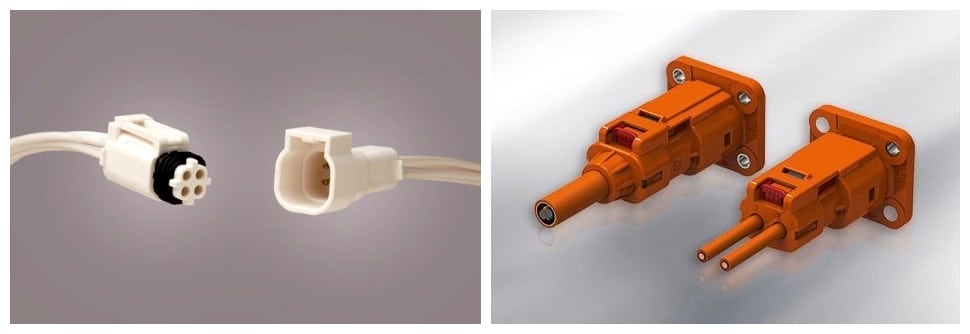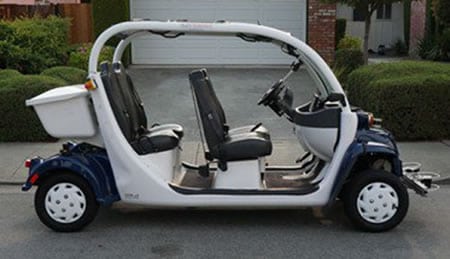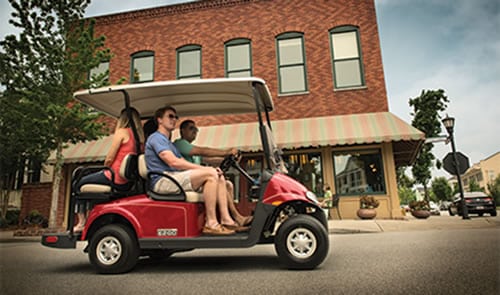Golf Carts Drive Towards Autonomy
Driverless golf carts and neighborhood electric vehicles may become mainstream well before autonomous cars become common.
By Terry Costlow
Golf cart suppliers have beat the auto industry in the race to electric power. Now they’re striving to make big inroads into the autonomous vehicle field. The challenges and benefits of using both electrified powertrains and driverless systems are expanding as carts extend their reach from golf courses to campuses and controlled living areas.
Slow speeds, relatively short driving distances, and somewhat-constrained operating hours on golf courses and in limited travel areas are among the factors that enabled the changeover from gasoline powertrain. Those same factors are now behind the emergence of autonomous golf carts.
Connector markets could grow solidly as these markets expand. High-power components that link batteries and motors will be a central market, along with connectors for auxiliary features like USB ports, which are becoming as popular in carts as cupholders are in conventional cars.

Molex ValuSeal Connectors (left) and TE Connectivity AMP+ HVA 280 High-Voltage Connectors
Connector manufacturers are already addressing both the power and data applications. TE Connectivity’s AMP Power Series meets the needs of many battery-related uses, carrying up to 600V with individually shielded wire or up to 850V with multicore wire at up to 40A. Molex takes a different tack with its ValuSeal Wire-to-Wire Connection System, which is rated IP65 and carries up to 11.5A. On the USB side, suppliers like Samtec offer a range of single and stacked connectors that meet the needs of cart designers. JAE also provides USB 3.0 connectors that are designed for this harsh environment.
Electric carts already dominate shipments in golf carts and neighborhood electric vehicles (NEVs), a solidly growing segment named for its energy source. A projected 7% compound annual growth (CAGR) is anticipated for golf carts through 2023, when the market will hit $2.6 billion. In 2016, golf cart sales were $1.6 billion. Electric vehicles already dominate the market and will grow at a slightly faster pace, 7.8% through 2023, driven by solid growth in North America. Low maintenance costs and government initiatives to reduce pollution are major drivers for the electric powered engine segment.
Some proponents of the technology believe golf carts may evolve into a mainstream market before driverless cars become commonplace. MIT and the National Research Foundation of Singapore tested a jointly developed autonomous NEV called SMART by carrying roughly 500 tourists around for six days.
The NEV used cameras and off-the-shelf laser rangefinders as sensors mounted at different heights to decide when to stop or turn. Researchers noted that it is easier to fuse sensor inputs and create reliable algorithms at the slow speeds of these carts. The research team said 98% or the tourists said they’d ride in the vehicle again.
Autonomous golf carts continue to expand the role of battery power as well. The engineers who design golf cart electronics are leveraging the huge investment in connectors for electric vehicles. ITT Cannon, Yazaki, Phoenix Contact, Amphenol, and many others offer connectors that bring standardization to charging for vehicles of any size.

Ingersoll Rand’s Club Car just unveiled a cart that doesn’t need a driver.
Ingersoll Rand, one of the four leading cart manufacturers, unveiled an autonomous vehicle in June 2018. As in the automotive industry, a handful of startups are also jockeying to gain a foothold in this nascent field, offering vehicles as well as caddies.
Club Car, an Ingersoll Rand operation, launched Tempo Walk, an autonomous golf caddie that lets golfers enjoy walking courses without having to expend their energy lugging a bag of clubs. It uses wireless technology, including GPS yardage and hands-free remote control to maneuver around courses. The aluminum caddy contains a lithium ion battery, which holds a 36-hole charge while moving at up to 7mph. Additional technology features on the 95-pound cart include a USB port and touchscreen tablet with GPS yardage.
CaddyTrek, the Mobile Autonomous Robotic Golf Cart Caddy, offers two tracking modes, both controlled by a module that’s typically attached to the golfer’s waistband. In one mode, users stand in front of the 39-pound caddy and engage the Follow Mode. They can also stand behind it to use Marching Mode. Another option is to use the Remote Mode to direct the CaddyTrek to the next tee box, using manual controls to guide it around bunkers or other obstacles.
Auro Robotics is creating autonomous vehicles that ferry people around universities, retirement communities, and resorts. In defined and limited environments like these, autonomous vehicles are generally free to operate without regulation. Auro’s prototype golf carts are equipped with laser scanners, radar, cameras, GPS, computers, and the sensing technology needed for autonomous operations.
One Auro NEV is being tested at Santa Clara University, and the spinout from a robotics project at the Indian Institute of Technology Kharagpur is also in the testing phase.

Auro’s cart is being tested at Santa Clara University.
While there’s a lot of interest in autonomy, most of the actual sales will remain in conventional carts. In this market, extending battery lifetimes remains a critical factor. Textron Specialized Vehicles’ E-Z-GO Express personal transport vehicles feature a 72-volt AC powertrain that gives users more power and range. Six 12-volt batteries and a 350-amp controller let the cart carry six passengers over longer distances, driving at speeds up to 16.5mph. The carts also offer dual USB ports, an onboard charger, and a state-of-charge meter.

Textron’s E-Z-Go uses a 72-volt powertrain to increase driving time.
As the automotive world continues to putt along in the development process of the autonomous car, smaller autonomous vehicles have already sunk a chip shot on self-driving innovation.
Interested in a specific market? Click a market below for current articles and news.
Automotive, Consumer, Industrial, Medical, Mil/Aero, Datacom/Telecom, and Transportation
- State of the Industry: 2022-2023 Connector Sales - April 16, 2024
- Amphenol is On a Roll - April 2, 2024
- Nicomatic Proves That Two Heads are Better Than One - March 26, 2024












